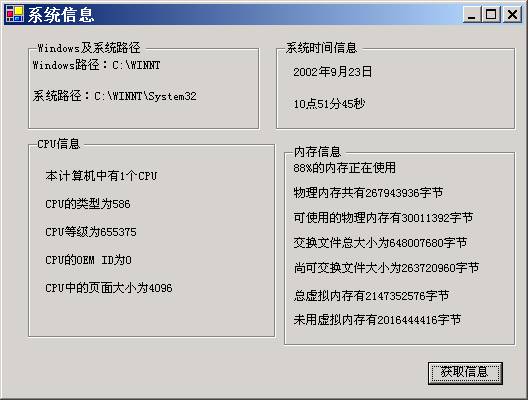C#程序设计获取系统信息的Windows窗体的背景许多软件都有自动关机功能,特别是在长时间下载的时候,这个功能可是使你不用以守候在计算机前面,而电脑却能按照您事先的设定自动关闭。现在我们用visual C#来编写一个多功能的关机程序。C#程序设计获取系统信息的Windows窗体是该程序的一部分,现在让我们来看看具体的过程。
C#程序设计获取系统信息的Windows窗体实现的步骤:
C#程序设计获取系统信息的Windows窗体实现1. 界面的设计
向工程中增加一个Windows窗体并向窗体中添加如下控件:

C#程序设计获取系统信息的Windows窗体实现2. 在窗体类中引用API函数
using System.Runtime.InteropServices ;
using System.Text ;
[ DllImport("kernel32") ]
public static extern void GetWindowsDirectory(StringBuilder WinDir,int count) ;
[ DllImport("kernel32") ]
public static extern void GetSystemDirectory(StringBuilder SysDir,int count) ;
[ DllImport("kernel32") ]
public static extern void GetSystemInfo(ref CPU_INFO cpuinfo) ;
[ DllImport("kernel32") ]
public static extern void GlobalMemoryStatus(ref MEMORY_INFO meminfo) ;
[ DllImport("kernel32") ]
public static extern void GetSystemTime(ref SYSTEMTIME_INFO stinfo) ;
- 1.
- 2.
- 3.
- 4.
- 5.
- 6.
- 7.
- 8.
- 9.
- 10.
- 11.
- 12.
以上几个API的作用分别是获取系统路径,获得CPU相关信息,获得内存的相关信息,获得系统时间等。
C#程序设计获取系统信息的Windows窗体实现3. 定义以下各结构
在声明完所有的API函数后,我们发现后三个函数分别用到了CPU_INFO、MEMORY_INFO、SYSTEMTIME_INFO等结构,这些结构并非是.Net内部的,它们从何而来?其实,我们在用到以上API调用时均需用到以上结构,我们将函数调用获得的信息存放在以上的结构体中,***返回给程序输出。这些结构体比较复杂,但是如果开发者能够熟练运用,那么整个API世界将尽在开发者的掌握之中。以下就是上述结构体的声明:
//定义CPU的信息结构
[StructLayout(LayoutKind.Sequential) ]
public struct CPU_INFO
{
public uint dwOemId ;
public uint dwPageSize ;
public uint lpMinimumApplicationAddress ;
public uint lpMaximumApplicationAddress ;
public uint dwActiveProcessorMask ;
public uint dwNumberOfProcessors ;
public uint dwProcessorType ;
public uint dwAllocationGranularity ;
public uint dwProcessorLevel ;
public uint dwProcessorRevision ;
}
file://定义内存的信息结构
[StructLayout(LayoutKind.Sequential) ]
public struct MEMORY_INFO
{
public uint dwLength ;
public uint dwMemoryLoad ;
public uint dwTotalPhys ;
public uint dwAvailPhys ;
public uint dwTotalPageFile ;
public uint dwAvailPageFile ;
public uint dwTotalVirtual ;
public uint dwAvailVirtual ;
}
file://定义系统时间的信息结构
[StructLayout(LayoutKind.Sequential) ]
public struct SYSTEMTIME_INFO
{
public ushort wYear ;
public ushort wMonth ;
public ushort wDayOfWeek ;
public ushort wDay ;
public ushort wHour ;
public ushort wMinute ;
public ushort wSecond ;
public ushort wMilliseconds ;
}
- 1.
- 2.
- 3.
- 4.
- 5.
- 6.
- 7.
- 8.
- 9.
- 10.
- 11.
- 12.
- 13.
- 14.
- 15.
- 16.
- 17.
- 18.
- 19.
- 20.
- 21.
- 22.
- 23.
- 24.
- 25.
- 26.
- 27.
- 28.
- 29.
- 30.
- 31.
- 32.
- 33.
- 34.
- 35.
- 36.
- 37.
- 38.
- 39.
- 40.
- 41.
- 42.
- 43.
C#程序设计获取系统信息的Windows窗体实现4. 编写窗体类的方法
private void button1_Click(object sender, System.EventArgs e )
{
file://调用GetWindowsDirectory和GetSystemDirectory函数分别取得Windows路径和系统路径
const int nChars = 128 ;
StringBuilder Buff = new StringBuilder(nChars) ;
GetWindowsDirectory(Buff,nChars) ;
WindowsDirectory.Text = "Windows路径:"+Buff.ToString( ) ;
GetSystemDirectory(Buff,nChars) ;
SystemDirectory.Text = " 系统路径:"+Buff.ToString( ) ;
file://调用GetSystemInfo函数获取CPU的相关信息
CPU_INFO CpuInfo ;
CpuInfo = new CPU_INFO( ) ;
GetSystemInfo(ref CpuInfo) ;
NumberOfProcessors.Text =
"本计算机中有"+CpuInfo.dwNumberOfProcessors.ToString( ) +"个CPU";
ProcessorType.Text = "CPU的类型为"+CpuInfo.dwProcessorType.ToString( ) ;
ProcessorLevel.Text = "CPU等级为"+CpuInfo.dwProcessorLevel.ToString( ) ;
OemId.Text = "CPU的OEM ID为"+CpuInfo.dwOemId.ToString( ) ;
PageSize.Text = "CPU中的页面大小为"+CpuInfo.dwPageSize.ToString( ) ;
file://调用GlobalMemoryStatus函数获取内存的相关信息
MEMORY_INFO MemInfo ;
MemInfo = new MEMORY_INFO( ) ;
GlobalMemoryStatus(ref MemInfo) ;
MemoryLoad.Text =
MemInfo.dwMemoryLoad.ToString( ) +"%的内存正在使用" ;
TotalPhys.Text =
"物理内存共有"+MemInfo.dwTotalPhys.ToString( ) +"字节" ;
AvailPhys.Text =
"可使用的物理内存有"+MemInfo.dwAvailPhys.ToString( ) +"字节" ;
TotalPageFile.Text =
"交换文件总大小为"+MemInfo.dwTotalPageFile.ToString( ) +"字节" ;
AvailPageFile.Text =
"尚可交换文件大小为"+MemInfo.dwAvailPageFile.ToString( ) +"字节" ;
TotalVirtual.Text =
"总虚拟内存有"+MemInfo.dwTotalVirtual.ToString( ) +"字节" ;
AvailVirtual.Text =
"未用虚拟内存有"+MemInfo.dwAvailVirtual.ToString( ) +"字节" ;
file://调用GetSystemTime函数获取系统时间信息
SYSTEMTIME_INFO StInfo ;
StInfo = new SYSTEMTIME_INFO( ) ;
GetSystemTime(ref StInfo) ;
Date.Text = StInfo.wYear.ToString( ) +
"年"+StInfo.wMonth.ToString( ) +"月"+
StInfo.wDay.ToString( ) +"日" ;
Time.Text = (StInfo.wHour+8).ToString( ) +
"点"+StInfo.wMinute.ToString( ) +"分"+
StInfo.wSecond.ToString( ) +"秒" ;
}
- 1.
- 2.
- 3.
- 4.
- 5.
- 6.
- 7.
- 8.
- 9.
- 10.
- 11.
- 12.
- 13.
- 14.
- 15.
- 16.
- 17.
- 18.
- 19.
- 20.
- 21.
- 22.
- 23.
- 24.
- 25.
- 26.
- 27.
- 28.
- 29.
- 30.
- 31.
- 32.
- 33.
- 34.
- 35.
- 36.
- 37.
- 38.
- 39.
- 40.
- 41.
- 42.
- 43.
- 44.
- 45.
- 46.
- 47.
- 48.
- 49.
- 50.
- 51.
C#程序设计获取系统信息的Windows窗体实现的基本情况就向你介绍到这里,希望对你了解和学习C#程序设计获取系统信息的Windows窗体实现有所帮助。
【编辑推荐】

























